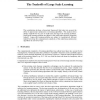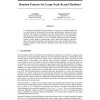122
click to vote
NIPS
2007
15 years 2 months ago
2007
This contribution develops a theoretical framework that takes into account the effect of approximate optimization on learning algorithms. The analysis shows distinct tradeoffs for...
85
Voted
NIPS
2007
15 years 2 months ago
2007
We combine three threads of research on approximate dynamic programming: sparse random sampling of states, value function and policy approximation using local models, and using lo...
115
click to vote
NIPS
2007
15 years 2 months ago
2007
Semi-supervised methods use unlabeled data in addition to labeled data to construct predictors. While existing semi-supervised methods have shown some promising empirical performa...
99
Voted
NIPS
2007
15 years 2 months ago
2007
We present a new class of models for high-dimensional nonparametric regression and classification called sparse additive models (SpAM). Our methods combine ideas from sparse line...
55
Voted
NIPS
2007
15 years 2 months ago
2007
102
Voted
NIPS
2007
15 years 2 months ago
2007
To accelerate the training of kernel machines, we propose to map the input data to a randomized low-dimensional feature space and then apply existing fast linear methods. The feat...
98
Voted
NIPS
2007
15 years 2 months ago
2007
Assessing similarity between features is a key step in object recognition and scene categorization tasks. We argue that knowledge on the distribution of distances generated by sim...
121
click to vote
NIPS
2007
15 years 2 months ago
2007
Reward-modulated spike-timing-dependent plasticity (STDP) has recently emerged as a candidate for a learning rule that could explain how local learning rules at single synapses su...
98
Voted
NIPS
2007
15 years 2 months ago
2007
In recent years, the language model Latent Dirichlet Allocation (LDA), which clusters co-occurring words into topics, has been widely applied in the computer vision field. Howeve...
NIPS
2007
15 years 2 months ago
2007
Rosetta is one of the leading algorithms for protein structure prediction today. It is a Monte Carlo energy minimization method requiring many random restarts to find structures ...


